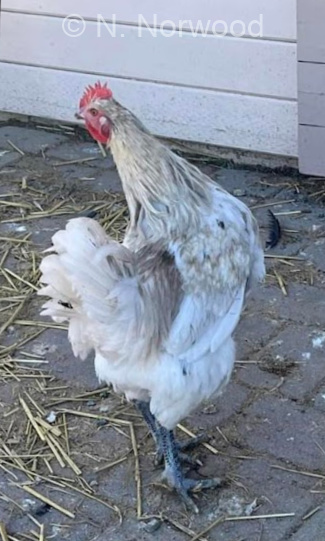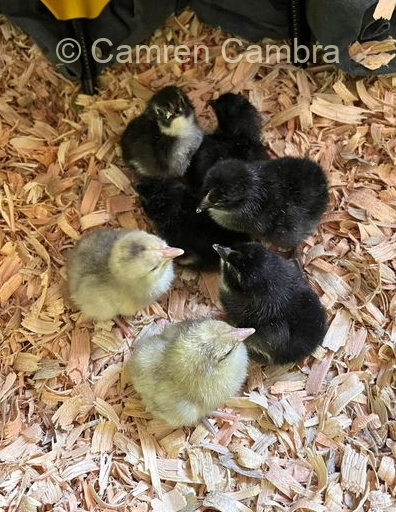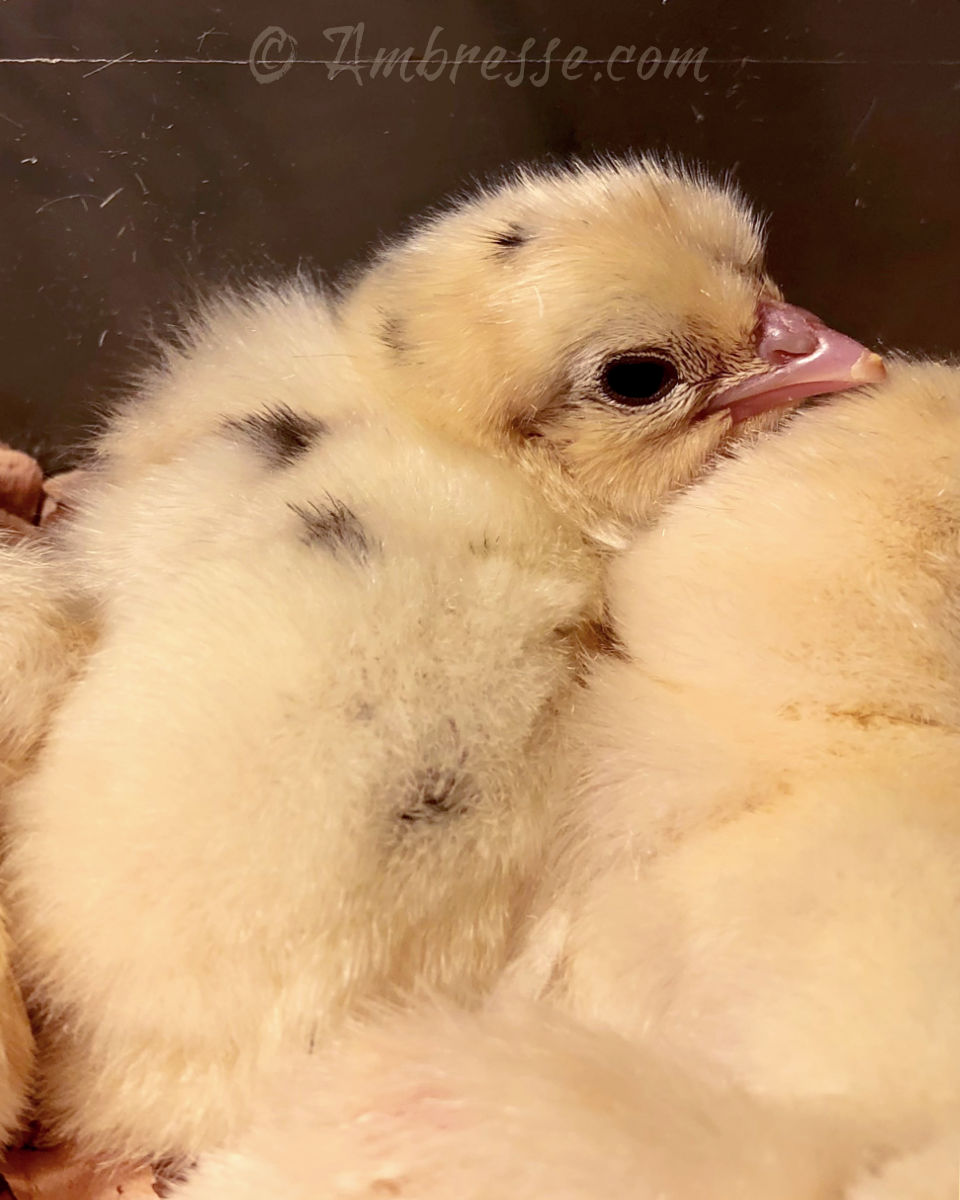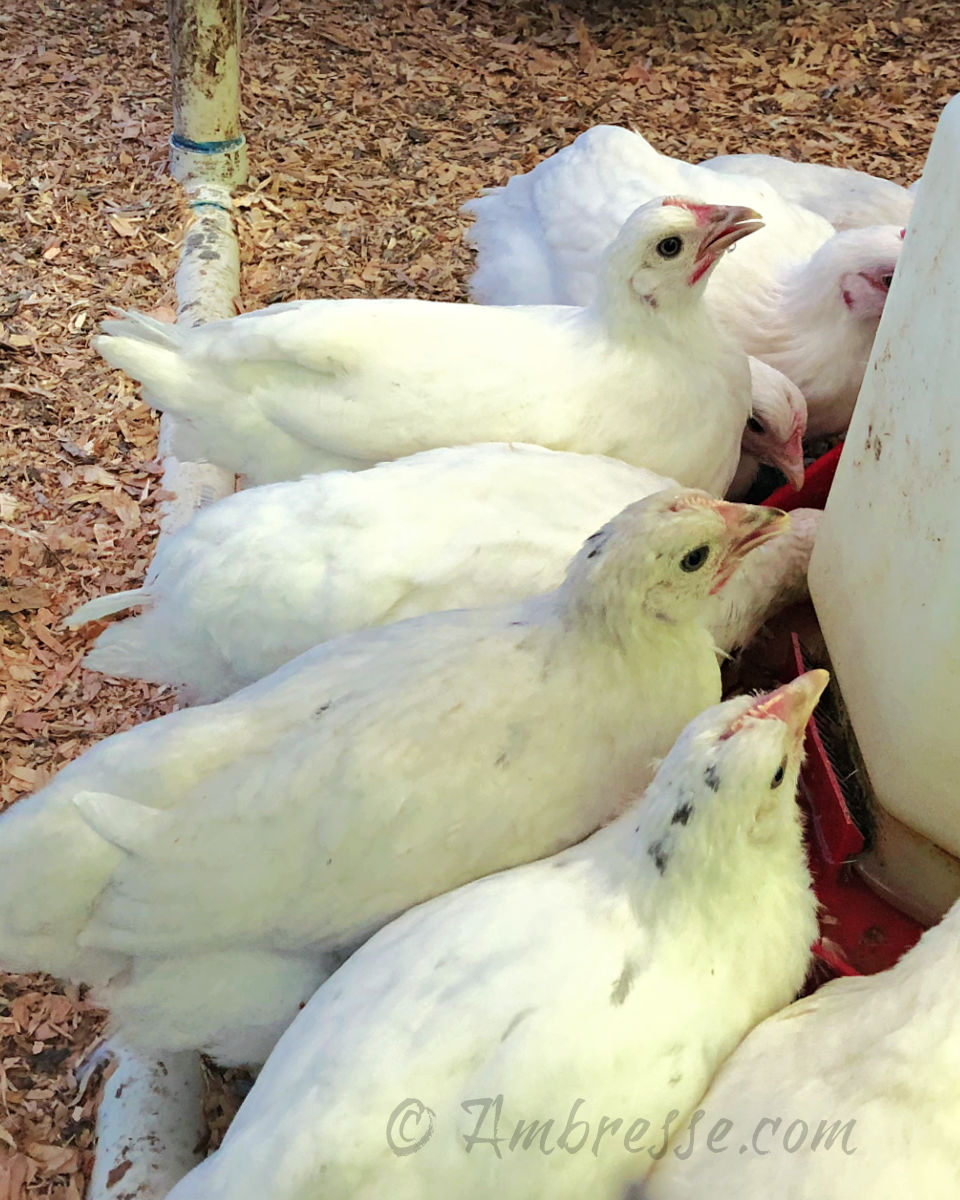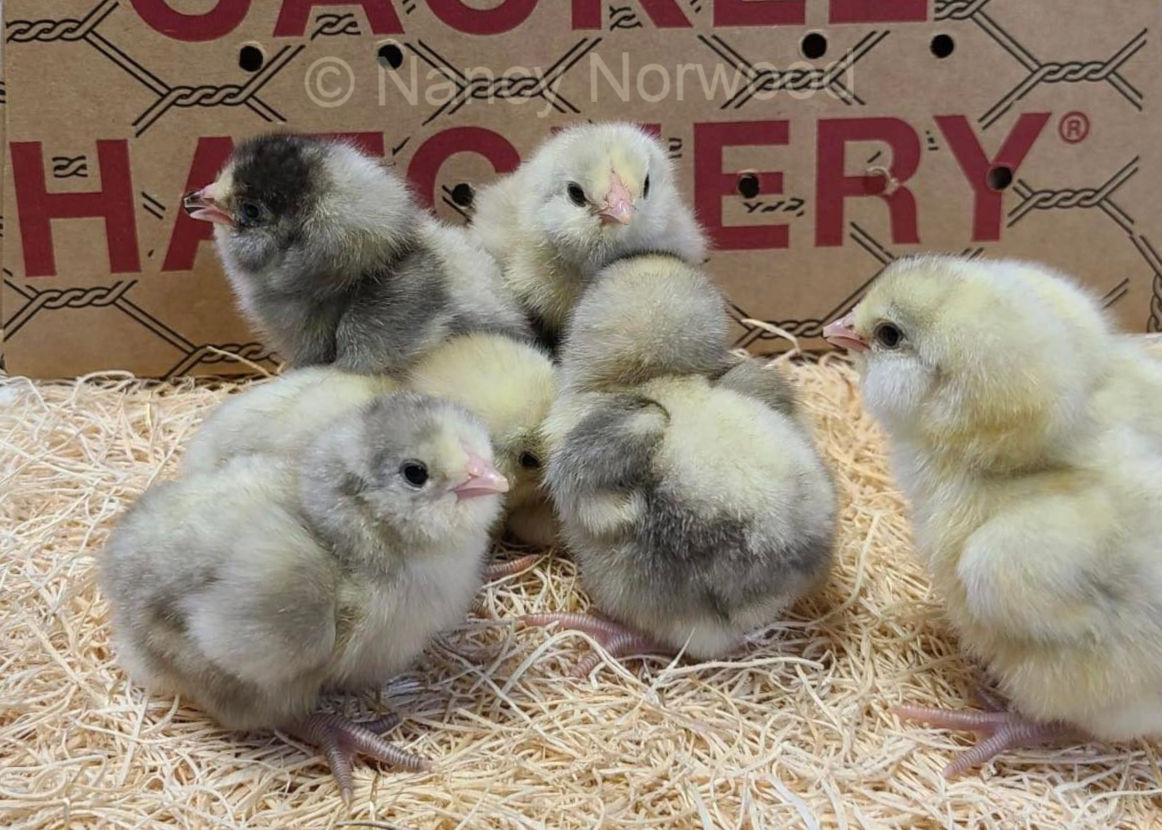White Genes in American Bresse
There are two white genes in American Bresse Chickens: Dominant White and recessive White. Here are the reasons why French Bresse breeders have chosen to keep Dominant White Bresse genes, and not Recessive White genes.
When white American Bresse chickens were imported from France, each one arrived with double copies of Dominant White genes which produce solid white plumage. The recessive white gene also came from France, but it did not come in white Bresse birds; it came hiding recessively in the color varieties of Bresse - Black, Blue, and Splash.
Let's talk about these two types of white genes! A big THANK YOU to Nancy Norwood for the article below, which helps to clarify differences between the two white genes, and provides reasons for best breeding practices and choices.
Dominant vs. Recessive White Genes in American Bresse Chickens
By Nancy Norwood
Let’s take a look at those recessive white and dominant white genes in American Bresse.
- Dominant White is incompletely dominant
- Recessive White is incompletely recessive to Dominant White.
- Both can be present in the same bird, which can cause big problems.
Neither gene is completely dominant over the other, and unfortunately we currently have both of these genes represented in the American Bresse gene pool.
Because these genes function differently, I thought it might be helpful to actually look at some photos and talk about how we can identify both.
Recessive White:
Two copies of recessive white in a COLORED flock results in a dusty yellow chick that matures into a snow white bird. It requires two copies of recessive white to result in a recessive white bird. (Pictured below.)
So, if you breed a black to a black and both carry white recessively, then you have a good chance of getting a recessive white chick. The same can happen with a blue x blue. If they both carry recessive white you can get a recessive white chick.
Two copies of recessive white in an otherwise DOMINANT WHITE flock results in...
- Chicks with grayish white down in some breeds (Huff, 174). This is also true of some flocks of American Bresse.
- Chicks with apparently normal fluffy light yellow down, which will mature into a white bird, just like every other white chicken in the dominant white flock. If your eye is not trained to see the minute nuances in shades of down, it may be extremely difficult (or impossible) to tell which chick is recessive white, and which have one or more dominant white genes.
Why is this important?
Because if you put that recessive white chick into your white flock with all of your other dominant white birds, you will begin to hatch chicks that are an ugly mess genetically, and you won’t know which bird the mess came from. Don't forget that dominant white birds are also masking a color.
Your first clue will probably be a few yellow chicks in the brooder with black spots. Who knew that white birds bred to white birds could result in spotted or even colored chicks? It's all there in the genetic instructions.
Black Spotted White Bresse Chicks: Is that a Splash, or...?
In white Bresse, it is almost certainly black leakage, which presents as a few black specks or feathers (pictured). The spots in this chick are evidence of ONE recessive white gene, and one dominant white gene.
According to F. B. Hutt4, "ticking and spotting are usual in heterozygous [dominant white] chicks and...feathers partly or wholly black are common in adults" (169). Black spots happen when a single dominant and a single recessive gene tango in the same bird - small spots of color in the white down and feathers, just like a poorly painted "streaky barn."
Incomplete Dominance is Like Painting a Barn
If I paint two coats of white paint over a black barn, I will have a white barn. It will take both coats to do a good job of it and turn the black barn well and truly white.
What happens if I paint only one coat of paint? Will some black streaks show through? You bet they will. That’s a picture of how dominant white works. The black or blue (or other colors) are always underneath.
A dominant white bird needs two genes for dominant white. If a bird only gets one gene for dominant white, then its base color “leaks” through.
Remember when I said that recessive white in your dominant white pen is a problem? What if you have dominant white (98% of Bresse) with recessive white carried in their gene pool?
You will inevitably end up with a genetic mess.
One copy of dominant white and one copy of recessive white produces a white bird with lots of color leakage. It's like every underlying color can leak through. It’s like an old house with multiple layers of paint that have been scraped off in a few places. Anything that is in the bird's genetics can leak through.
Because mixing dominant and recessive white genes in the same flock is sure to result in incorrectly colored chickens, you can avoid the entire genetic headache by NOT mixing the two white genes in American Bresse flocks.
Disadvantages of Recessive White Genes in American Bresse
Genes do things. They have consequences. Using recessive white genes in American Bresse flocks may affect the breed as a whole. But first, it will affect individual flocks, and I'm not sure whether it will be for better or for worse.
Given the fact that the White American Bresse breed as a whole is made up of mainly Dominant White birds, here are SIX known consequences to injecting recessive white genetics into a dominant white American Bresse flock.
- Reduced size. According to data collected by Smythe and Fox over multiple studies between the '60s and early 80s2, recessive white genes somewhat depress growth rate, by 4% to 10%. This should give pause to all breeders breeding to the Standard of Perfection, and to any that have commercial poultry aspirations.
- Recessive White is disadvantageous in Commercial Usage: A reduction of the average size of every poultry product leaving your farm can negatively impact one's income. If on processing day at 16 weeks of age, dominant white birds are 6.0 pounds but recessive whites are 5.5 pounds, why CHOOSE to raise birds that will yield consistently 6-7% less per month or year than the dominant white flocks, especially as the American Bresse Standard of Perfection indicates a goal of slightly larger birds rather than smaller ones?
This size reduction even if slight, is genetic, meaning that without a lot of selective breeding, the capacity for bigger growth is limited. - Color Leakage. Unless the ENTIRE GROUP of White American Bresse breeders continent-wide choose to abandon the dominant gene and embrace AS A WHOLE the recessive gene, "franken-birds" will become a regular occurrence with every hatch. That is because the genetic codes work that way. Dominant white combined with recessive white messes up the color outcomes; no way to get around it. If you're honest, you know this will cut into the profit margin of a commercial enterprise.
Some breeders may choose to breed exclusively recessive white, and others may choose to breed exclusively dominant white. That is all well and good as long as two completely separate gene pools are maintained. The minute one mixes dominant and recessive white in the same flock, the Standard-of-Perfection-destroying color leakage will become a thing again, wherever the mixture occurs.
A breeder will eventually want to figure out the source(s) so he can clean up the gene pool and eliminate the color leakage.
A homesteader or homemaker may not care a single whit. Which is fine - spotted birds are fully Bresse. While their white genes may be mismatched, their eggs are still copious, and their meat is as delicious as any American Bresse meat is. - Deciphering which white birds carry which combination of white genes will be a nightmare. This is because "white" is layering on top of "white." If you're fortunate, the recessive white chicks will give you some clue as to their genetic makeup. But most of the time there is no obvious way to determine whether a particular bird is homozygous dominant white, homozygous recessive white, or heterozygous for both (one copy of each white gene).
BUT: I recently discovered a company that can do genetic testing for the recessive white gene: IQ Bird Testing. For a price, this genetic laboratory can test for the presence of the recessive white gene ("c"), and its pair, the color gene ("C"). You can send in as many samples as you care (or can afford) to submit. Check them out! - Recessive is easy to counterfeit. An unscrupulous individual anxious to make a buck might be willing to try to slap recessive white feathers and blue legs on birds with single red combs, and then fraudulently call them "Bresse." See the history of the Blue Foot Chicken for an example of "breed creation." Thankfully the creators did not call their new bresse-like chicken a Bresse.
- There is a big danger of losing uniquely bresse traits such as the fat marbling and exquisite flavor, should genetic manipulation not be done very carefully or wisely. According to Chef Tom Colicchio, as reported in the NYMag.com, "Nothing quite compares to a Bresse."
All traits, including the less tangible bresse traits, are either based in the genes or are epigenetic in nature. One can very easily lose uniquely bresse traits by chasing other traits such as color or size through hybridization.
This DID happen in the case of the Blue Foot Chicken. It would be a tragedy if North American breeders did not wisely steward the gift that is the American Bresse breed.
Use of dominant white genes was the chosen path of the original French breeders for the last five hundred years, for at least the above reasons. They minimized fraud and gene dilution through legal protections, maintained bird size within their desired parameters, and now they control the extent of yellowing via selective breeding.
Okay, so Dominant White IS Prone to Yellowing....
The singular drawback to the dominant white gene in the minds of some breeders is the propensity to yellowing. Because it is dominant to black but incompletely dominant to yellow pigment, dominant white can allow for some leakage of yellow pigment into the plumage, especially in roosters, in some cases more so than others.
The ability to completely eliminate yellowing sounds like a brilliant idea to some breeders. But, let's finish thinking this through!
After five hundred years, the French STILL keep their dominant white flocks and their legal protections. It ain't broke and they're not trying to fix anything. Yes, in France one can still see tinges of yellowing in Bresse roosters. Yellowing can be minimized over several breeding seasons through using solid black (not silver) as a base color, and then selectively breeding the birds with the least yellowing.
Don't forget that dominant white birds are up to 1.5 pounds heavier than recessive white pasture-mates. If that means a slightly higher income potential, I'm happy to keep the dominant white genes with the yellowing and accept the challenge of selectively breeding toward whiter plumage.
Eliminating Recessive White Out of the Flock
Recessive white genes came to North America in colored Bresse imported from France. They were then mistakenly introduced into our dominant white stock. Now we are already seeing these recessive white genes popping up more and more in our dominant white flocks. The mixed dominant and recessive birds that show the obvious black leakage lets the breeder know that the recessive gene has entered the flock. Any chicks that are 100% recessive white will likely fly under the radar for awhile, making your job of finding them all very difficult.
Recessive white should be selected away from, most especially in the dominant white flock, but also in colored flocks as well.
Here are some clues to look for. If the job of identification proves too difficult, I recommend either starting over with dominant white stock from a reputable breeder, or implementing genetic testing so you can cut to the chase and begin hatching 100% dominant white chicks with no black spots.
Recessive White in Color Flocks...
In color flocks, the recessive white chicks will stick out like a sore thumb. They are those few dusty white chicks amongst the full color ones. Those chicks are homozygous recessive white (two matching genes). They are easy to identify. If you breed two colored birds together and get a white chick, it must be a recessive white. These chicks will grow into snowy white adults. (The gray sheen goes away entirely.) You can’t always tell them apart once they grow into their adult plumage.
The presence of recessive white chicks means that BOTH the rooster and the hen are recessive white carriers. (If you haven't pair-hatched, you'll need to determine which birds are the parents.)
DON'T SELL your recessive white chicks as breeders! They ARE delicious and the white feathers pluck cleanly. But if your freezer is already full, sell them as egg-layers to families and homesteads. Do the right thing and ensure that your customer knows the genetics are incorrect, and therefore they are not for resale, but only for family use.
DON’T buy a recessive white bird and put it in your dominant white flock! Ask the breeder before buying. Are you getting recessive whites in your black/blue/splash flock? Don't put them in with the dominant white flock! Please recognize that Recessive White birds and Dominant White birds are two completely different fowl, and very poorly compatible (Hutt, 175), despite the fact that they look very similar.
In the photo at the top of the page you can see the leakage I was talking about. The young cockerel is possibly a pure American Bresse but because of the existence of the two conflicting genes, the "paint" is leaking both black and gray/cream.
Recessive White Genes in Dominant White Flocks...
IDENTIFY carriers of the Recessive White gene and any Recessive White birds. This is difficult, since both the dominant and the recessive white usually look virtually identical in adult birds. In time, you may be able to pick up on the clues that are specific to your particular flock:
- A lighter shade of yellow down, OR a more obvious grayish white down. White American Bresse chicks should have yellow down.
- Legs darkening very early.
- Pristine white adult feathers without yellowing. (BUT, this might also be true of Dominant White birds with a solid black genetic background or sufficient whitening modifiers.)
- Any chicks with black leakage spots or off-color gray/white chicks or started birds mean they must have ONE recessive white gene. As chicks with leakage grow, some will appear beautifully white with the exception of a few scattered black specks or black feathers. Others will molt into muddy grayish white plumage of varying hues, from just a hint of off-color, to an appearance of bluish gray, possibly with flecks of stronger color. And in a few cases, it may be very difficult to find any evidence of leakage. But the mismatch in genetics is sure to resurface in a later generation.
- Take steps to track back any spotted chicks to the sire and dam, because ONE of those parent birds will have donated the single recessive white gene. In this manner, over time, you may be able to suss out the suspect birds and eliminate the recessive genetics from the breeding flock.
Could Beak Color Help Identify the Recessive White Bird in Your Dominant White Flock? An interesting observation by Camren Cambra is that the 100% recessive white birds (not the dominant/recessive mix) tend to have white beaks. This would also be a fantastic way to identify them if you have any in your adult dominant white flocks.
If these recessive white genes in American Bresse can be identified and pulled out, you can stop getting the accidental spotted chicks and leakage adults! I know I have a recessive white hen in my dominant white pen because she has produced the boy in the top photo. I know her egg color and I don’t hatch them, but finding her is a huge problem, so I’m excited to look for her!
I hope these tips help you to sort your birds and hatch less leakage!!
Good hatching!

About Nancy Norwood
Despite her decades of chicken-breeding experience, Nancy Norwood prefers not to use the fancy nomenclature of geneticists. Instead, she talks genetics in a way that most everyone can understand. "I didn't learn with official terminology," she says. "I learned by doing. My education might be old school, but having even a basic grasp of genetics can help our flocks improve."
Connect with Nancy:
Web Presence: https://www.facebook.com/groups/1167240537084519/
Breeder Details and Contact Info: See BC Ranch in AZ
- Home
- White Genes in American Bresse
Research, edits, and formatting by Karen Patry, Ambresse.com
References for White Genes in American Bresse:
- Credit for the chick photo goes to Camren Cambra, an American Bresse breeder in Hawaii. Thank you! Photo used with permission.
- https://www.sciencedirect.com/science/article/pii/S0032579119427752
- https://www.facebook.com/groups/599945557327483/permalink/1169891506999549/
- Genetics of the Fowl: The Classic Guide to Poultry Breeding and Chicken Genetics, by F. B. Hutt. Norton Creek Press, 2003.
Overheard...
Tasty Recipe! "I processed my first batch of Bresse... Today I roasted one according (somewhat) to the recipe posted on Ambresse. It was delicious! Tender, moist and succulent... So happy I chose this breed!" (B.E., MN, 12/11/2024).
Success: "I can't believe all the inquiries we get through your website. And it's been a great resource to send people to who are interested in the (AB) breed" (Utangard Farm, NH, 5/5/2025).
Informational: "Your site has the first accurate information about American Bresse chickens that I have seen in English. Thanks for your diligent work" (L. Wooton, NC, 12/17/2024).
Translate This Page
Traduire Cette Page
Traduzca Esta Pagina

News
American Bresse Breed Club web pages can be found under the Breed Club tab on the navigation bar. Any changes in Club status will be posted here!
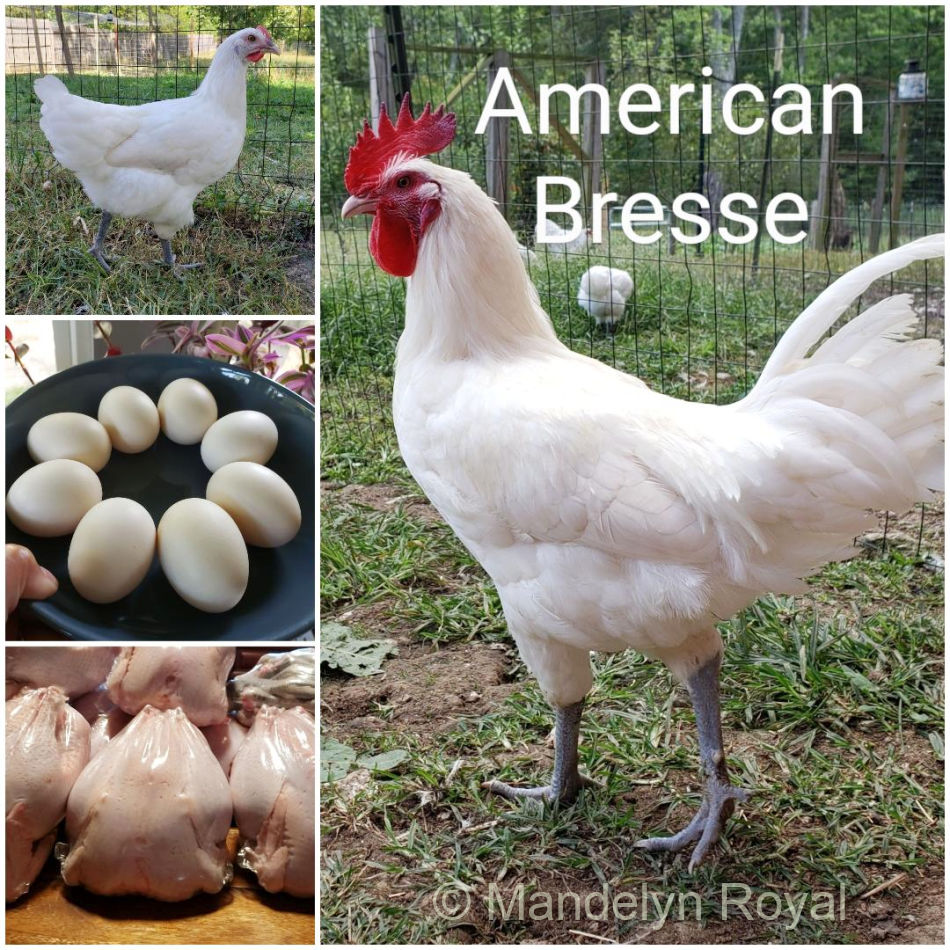
Photo credit: Mandelyn Royal.
